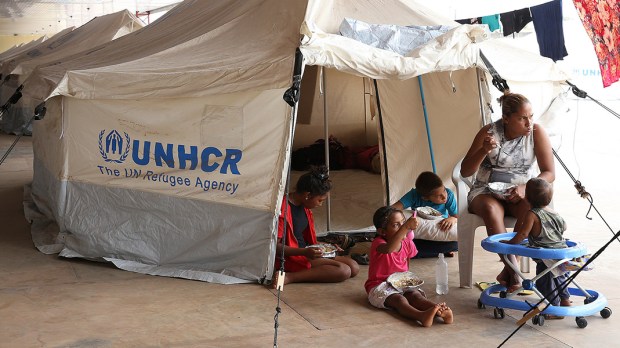Worldwide, there are approximately four million refugee children who do not have access to education, an increase of half a million in the period of just one year. Not counting Palestinian refugee children, the number represents more than half of the 7.4 million school-aged refugees. These are the results of the new report Turn the Tide: Refugee Education in Crisis, issued on Wednesday, August 29, by the UNHCR (United Nations High Commissioner for Refugees).
According to the UN agency’s estimates, at the end of 2017 there were 25.4 million refugees worldwide, of which nearly 20 million were under the UNHCR’s mandate. A little more than half, 52 percent, were minors, of which 7.4 million were school-aged.
Even though half a million children were enrolled in schools in 2017, the enrollments aren’t managing to keep up with the “rapidly growing” refugee population, despite the efforts of the international community, the report states.
Years of schooling
The document shows that only 61 percent (less than two thirds) attend elementary school, compared to 92 percent of children worldwide. This disparity in schooling increases as the children grow up.
Nearly two thirds of refugee children fail to make the step from primary school to secondary school. Indeed, only 23 percent—less than a fourth—of refugee children attend secondary school, compared to 84 percent of the children in the world, the report states.
When it comes to the high school, this disparity becomes an authentic abyss, according to the UNHCR report. While the global level of participation in higher education is 37 percent, among young refugees it’s just 1 percent, a percentage that has remained “unchanged for the past three years,” the Turn the Tide report affirms.
If in general refugee children have less opportunity to study than other children their age who aren’t refugees, this is particularly true in low-income countries, which are “disproportionately affected” by the movement of refugees, the document states.
According to the report, in 2017 developing regions hosted as many as 92 percent of school-aged refugees. “In low-income countries, less than half of primary-age refugee children get to go to school,” the UN document explains. “At secondary level, only 11 percent have the same opportunity.”
Refugee children
The report’s authors also discuss the particular situation of refugee girls, who are forced to “face even greater barriers to education.” In Kenya and Ethiopia, there are only seven girls for every 10 boys in primary school, and only four girls for every 10 boys in secondary school.
“If refugee girls can get an education, their families and communities are more likely to improve their social and economic position,” the report explains. An extra year of education can make a woman’s income increase by 20 percent, the document reveals.
If all women were to receive primary education, the number of child deaths from illnesses such as diarrhea, malaria, and pneumonia would decrease, the report’s authors explain. For example, deaths from diarrhea, the third most common cause of child mortality, would drop by 8 percent if all mothers completed primary education, and by as much as 30 percent if they had access to secondary education.
Exposed to the elements
The daily reality of refugee children who have the fortune to be able to attend school is still frequently not easy. They lack a bit of everything, from textbooks to classrooms. “When it rains everything gets wet,” says 14-year-old Irahoze Diello, a refugee from Burundi who now lives in the Nduta refugee camp in Tanzania.
“Irahoze is one of about 200 refugee children who study at Furaha Primary School, where classes are held in the open air,” the report explains. There is also a “troubling gender gap”: for every girl who attends school, there are three boys.
The children at refugee camps or informal settlements in Cox’s Bazar, in Bangladesh, where more than 700,000 Rohingya refugees who fled neighboring Myanmar (formerly Burma) live in precarious conditions, have to deal with the often devastating monsoon rains.
But the children, such as 12-year-old Minara, don’t let themselves get discouraged, because their stay at the Kutupalong settlement offers them an opportunity: for the first time in their lives, they can go to school, even if it’s only an improvised one. Refugees in Bangladesh don’t have access to formal education, UNHCR reports.
DAFI, IKEA …
In its report, the UN agency also emphasizes the importance of partnerships, not only with governments, humanitarian organizations, and NGOs for development, but also with the private sector.
Among the many initiatives, Turn the Tide mentions the German program DAFI (the acronym for Deutsche Akademische Flüchtlingsinitiative Albert Einstein), which grants scholarships to young people recognized as refugees so they can continue their higher studies in the countries where they have found asylum. Initiated in 1992 in collaboration with UNHCR, the program has already helped more than 14,000 young people, including Somali student Hawo Jehow Siyad.
Having arrived in 2000 at the Dadaab refugee camp in Kenya, Hawo was able to finish primary and secondary school at the camp. Thanks to a scholarship from DAFI, she then graduated from the University of Nairobi. Hawo has returned to her home country, where she works today as a database officer.
Another example of partnership is that between UNHCR and the Ikea Foundation, which in 2012 made it possible to launch a microcredit program for refugees in the Dollo Ado region of southeastern Ethiopia, close to the Somali border.
Thanks to the accord with the Swedish foundation, by the end of 2017, 47,000 refugee children were going to school: more than twice the number in 2012. At the beginning of 2018, a new teacher training college was inaugurated, where 200 Ethiopian students and 23 refugee students are now studying to become teachers. The first generation will graduate in 2020.
The words of the United Nations High Commissioner for Refugees
In the introduction to the document, the High Commissioner of the United Nations for Refugees, Filippo Grandi, explains that “education is a way to help young people heal, but it is also the way to revive entire countries.” Without education, the Italian diplomat says, “their future, and eventually the future of their communities, will be irrevocably damaged.”
While he describes how refugees often spend several years, and even decades, in exile—sometimes their entire childhood and youth—”school is often the first place they start to regain normality – safety, friendship, order, peace,” Grandi says. Even though children are “extraordinarily resilient,” there is a need for urgent investments to avoid hundreds of thousands of children becoming part of “these disturbing statistics.”
The UN High Commissioner also makes an appeal to the international community to include refugee children in the national education systems of their host countries, because “education is one of the most important ways to solve the world’s crises.”

